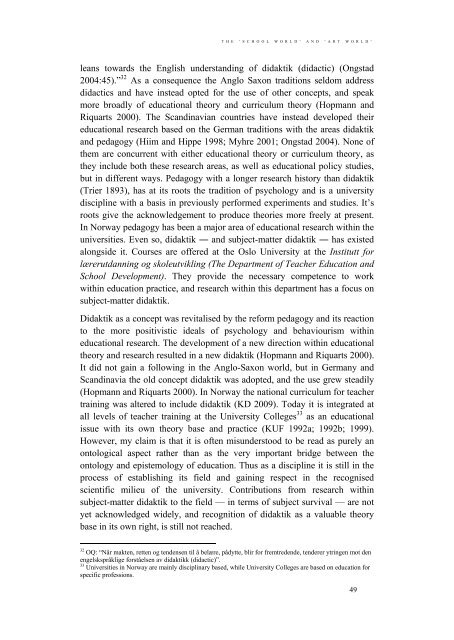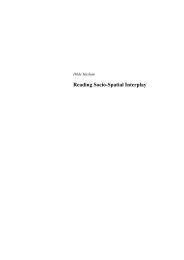CON ⢠TEXT - Arkitektur- og designhøgskolen i Oslo - AHO
CON ⢠TEXT - Arkitektur- og designhøgskolen i Oslo - AHO
CON ⢠TEXT - Arkitektur- og designhøgskolen i Oslo - AHO
- No tags were found...
You also want an ePaper? Increase the reach of your titles
YUMPU automatically turns print PDFs into web optimized ePapers that Google loves.
T H E ’ S C H O O L W O R L D ’ A N D ’ A R T W O R L D ’leans towards the English understanding of didaktik (didactic) (Ongstad2004:45).” 32 As a consequence the Anglo Saxon traditions seldom addressdidactics and have instead opted for the use of other concepts, and speakmore broadly of educational theory and curriculum theory (Hopmann andRiquarts 2000). The Scandinavian countries have instead developed theireducational research based on the German traditions with the areas didaktikand pedag<strong>og</strong>y (Hiim and Hippe 1998; Myhre 2001; Ongstad 2004). None ofthem are concurrent with either educational theory or curriculum theory, asthey include both these research areas, as well as educational policy studies,but in different ways. Pedag<strong>og</strong>y with a longer research history than didaktik(Trier 1893), has at its roots the tradition of psychol<strong>og</strong>y and is a universitydiscipline with a basis in previously performed experiments and studies. It’sroots give the acknowledgement to produce theories more freely at present.In Norway pedag<strong>og</strong>y has been a major area of educational research within theuniversities. Even so, didaktik ― and subject-matter didaktik ― has existedalongside it. Courses are offered at the <strong>Oslo</strong> University at the Institutt forlærerutdanning <strong>og</strong> skoleutvikling (The Department of Teacher Education andSchool Development). They provide the necessary competence to workwithin education practice, and research within this department has a focus onsubject-matter didaktik.Didaktik as a concept was revitalised by the reform pedag<strong>og</strong>y and its reactionto the more positivistic ideals of psychol<strong>og</strong>y and behaviourism withineducational research. The development of a new direction within educationaltheory and research resulted in a new didaktik (Hopmann and Riquarts 2000).It did not gain a following in the Anglo-Saxon world, but in Germany andScandinavia the old concept didaktik was adopted, and the use grew steadily(Hopmann and Riquarts 2000). In Norway the national curriculum for teachertraining was altered to include didaktik (KD 2009). Today it is integrated atall levels of teacher training at the University Colleges 33 as an educationalissue with its own theory base and practice (KUF 1992a; 1992b; 1999).However, my claim is that it is often misunderstood to be read as purely anontol<strong>og</strong>ical aspect rather than as the very important bridge between theontol<strong>og</strong>y and epistemol<strong>og</strong>y of education. Thus as a discipline it is still in theprocess of establishing its field and gaining respect in the rec<strong>og</strong>nisedscientific milieu of the university. Contributions from research withinsubject-matter didaktik to the field — in terms of subject survival — are notyet acknowledged widely, and rec<strong>og</strong>nition of didaktik as a valuable theorybase in its own right, is still not reached.32 OQ: “Når makten, retten <strong>og</strong> tendensen til å belære, pådytte, blir for fremtredende, tenderer ytringen mot denengelskspråklige forståelsen av didaktikk (didactic)”.33 Universities in Norway are mainly disciplinary based, while University Colleges are based on education forspecific professions.49
















